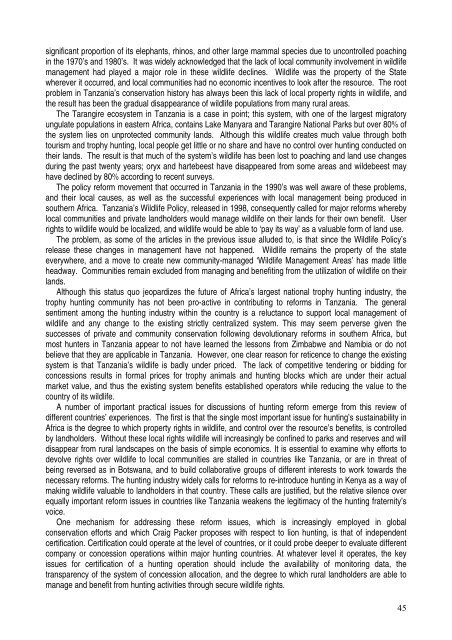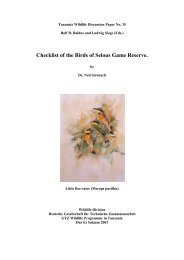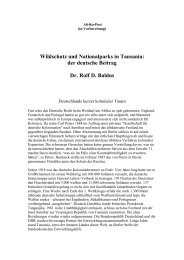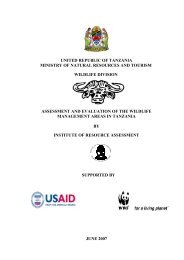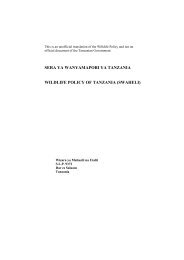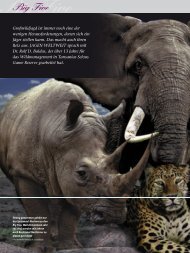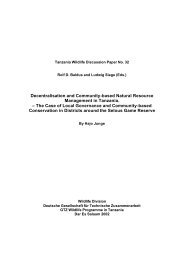African Indaba Articles - wildlife-baldus.com
African Indaba Articles - wildlife-baldus.com
African Indaba Articles - wildlife-baldus.com
Create successful ePaper yourself
Turn your PDF publications into a flip-book with our unique Google optimized e-Paper software.
significant proportion of its elephants, rhinos, and other large mammal species due to uncontrolled poachingin the 1970’s and 1980’s. It was widely acknowledged that the lack of local <strong>com</strong>munity involvement in <strong>wildlife</strong>management had played a major role in these <strong>wildlife</strong> declines. Wildlife was the property of the Statewherever it occurred, and local <strong>com</strong>munities had no economic incentives to look after the resource. The rootproblem in Tanzania’s conservation history has always been this lack of local property rights in <strong>wildlife</strong>, andthe result has been the gradual disappearance of <strong>wildlife</strong> populations from many rural areas.The Tarangire ecosystem in Tanzania is a case in point; this system, with one of the largest migratoryungulate populations in eastern Africa, contains Lake Manyara and Tarangire National Parks but over 80% ofthe system lies on unprotected <strong>com</strong>munity lands. Although this <strong>wildlife</strong> creates much value through bothtourism and trophy hunting, local people get little or no share and have no control over hunting conducted ontheir lands. The result is that much of the system’s <strong>wildlife</strong> has been lost to poaching and land use changesduring the past twenty years; oryx and hartebeest have disappeared from some areas and wildebeest mayhave declined by 80% according to recent surveys.The policy reform movement that occurred in Tanzania in the 1990’s was well aware of these problems,and their local causes, as well as the successful experiences with local management being produced insouthern Africa. Tanzania’s Wildlife Policy, released in 1998, consequently called for major reforms wherebylocal <strong>com</strong>munities and private landholders would manage <strong>wildlife</strong> on their lands for their own benefit. Userrights to <strong>wildlife</strong> would be localized, and <strong>wildlife</strong> would be able to ‘pay its way’ as a valuable form of land use.The problem, as some of the articles in the previous issue alluded to, is that since the Wildlife Policy’srelease these changes in management have not happened. Wildlife remains the property of the stateeverywhere, and a move to create new <strong>com</strong>munity-managed ‘Wildlife Management Areas’ has made littleheadway. Communities remain excluded from managing and benefiting from the utilization of <strong>wildlife</strong> on theirlands.Although this status quo jeopardizes the future of Africa’s largest national trophy hunting industry, thetrophy hunting <strong>com</strong>munity has not been pro-active in contributing to reforms in Tanzania. The generalsentiment among the hunting industry within the country is a reluctance to support local management of<strong>wildlife</strong> and any change to the existing strictly centralized system. This may seem perverse given thesuccesses of private and <strong>com</strong>munity conservation following devolutionary reforms in southern Africa, butmost hunters in Tanzania appear to not have learned the lessons from Zimbabwe and Namibia or do notbelieve that they are applicable in Tanzania. However, one clear reason for reticence to change the existingsystem is that Tanzania’s <strong>wildlife</strong> is badly under priced. The lack of <strong>com</strong>petitive tendering or bidding forconcessions results in formal prices for trophy animals and hunting blocks which are under their actualmarket value, and thus the existing system benefits established operators while reducing the value to thecountry of its <strong>wildlife</strong>.A number of important practical issues for discussions of hunting reform emerge from this review ofdifferent countries’ experiences. The first is that the single most important issue for hunting’s sustainability inAfrica is the degree to which property rights in <strong>wildlife</strong>, and control over the resource’s benefits, is controlledby landholders. Without these local rights <strong>wildlife</strong> will increasingly be confined to parks and reserves and willdisappear from rural landscapes on the basis of simple economics. It is essential to examine why efforts todevolve rights over <strong>wildlife</strong> to local <strong>com</strong>munities are stalled in countries like Tanzania, or are in threat ofbeing reversed as in Botswana, and to build collaborative groups of different interests to work towards thenecessary reforms. The hunting industry widely calls for reforms to re-introduce hunting in Kenya as a way ofmaking <strong>wildlife</strong> valuable to landholders in that country. These calls are justified, but the relative silence overequally important reform issues in countries like Tanzania weakens the legitimacy of the hunting fraternity’svoice.One mechanism for addressing these reform issues, which is increasingly employed in globalconservation efforts and which Craig Packer proposes with respect to lion hunting, is that of independentcertification. Certification could operate at the level of countries, or it could probe deeper to evaluate different<strong>com</strong>pany or concession operations within major hunting countries. At whatever level it operates, the keyissues for certification of a hunting operation should include the availability of monitoring data, thetransparency of the system of concession allocation, and the degree to which rural landholders are able tomanage and benefit from hunting activities through secure <strong>wildlife</strong> rights.45


